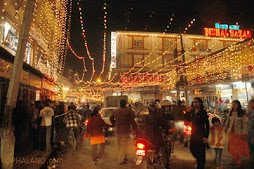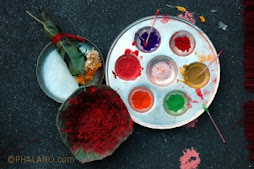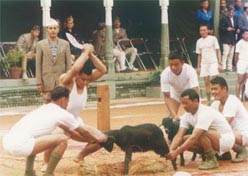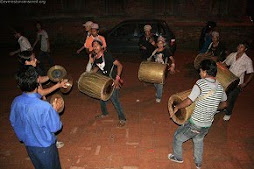The nice thing about the start of Dashain was that it also coincided with the kite season. Now-a-days flying a kite in Kathmandu is not as common as it used to be, this splendid sport used to be the favorite pasttime of kids and adults alike in the 70s. One could see hundreds of kites on Kathmandu’s sky gliding elegantly or fighting a fierce battle with one another and pulling all the tricks it could to bring someone else down. I suppose the sport fell victim to growing popularity of technology-driven entertainment and ATARI and other games of the late 80s and 90s. Kite flying, marbles (guccha), tash (cards), and other sports like tel kasa (game that involves giving a chase), aas paas (hide and seek) began to disappear slowly and if you ask young kids these days if they played any such games I bet with the exception of kite flying they would not have a clue how these games are played.
Anyway, flying a kite gave us tremendous joy, just like how the author of The Kite Runner describes in the book. We had to go to Ason Tole to buy the best kites, the kites came in a dazzle of colors. The kite flying apparatus consisted of the kite (made of paper) itself, the wooden reel with two spools on either side which you had to hold in your hands to manipulate the kite as it is airborne. Miles and miles of string were rolled onto the reel. The string was often fortified with homemade manja, a mixture of crushed glass and thick adhesive. The strength of the string depended on the quality of the mixture. I was not good at flying kite; I tried several times but never could master the art. Some of my friends were excellent kite flyers so I used to visit them in their house. We would go to the roof and spent hours flying the kite and engaging with others on kite fights. Depending on wind conditions and wind directions, we positioned our kites in a way that it would reach very high up in the sky. The kite would slowly rise up, sometimes dancing like a beautiful ballerina, and at other times furious as a dragon warrior. We always made sure that before we engaged in a fight we had ample time to enjoy the high flying and the theatrics in the sky.
There were different types of kites in the sky, some were big some small. Some had “two color” pattern, some were three or four colors, most kites we flew were square shaped. Most Nepali kites were of the Malay variety: a two sticker without a tail, both sticks of equal length crossed and tied with center of one at a spot one-seventh the distance from the top of the other; a bridle attached to the kite had two legs, one from the top of the diamond and the other from the lowest point, meeting a little below the crossing of the sticks; a string pulled tight across the back of the cross stick bowed the surface making the kite self-balancing. The Nepali kites were mostly made of lokta hand-made paper. Because the kites did not come with a tail attached, sometimes, we would make the tails ourselves. It was a pure joy to see the kite twisting and turning its tail as it became airborne and flew higher and higher. The sight of the colorful kites against the blue sky and the sounds (of yells, hoots, cheers, laughs, and occasional curses) made kite flying a memorable affair.
The kite fights were intense, the successful fighters were those who could anticipate the moves of their rivals, and of course who had championed the art and whose strings were the strongest. The manja fortified strings could strike a terror on unsuspecting kites. On any given day, you could see several kite duels in the sky and even if you were just a spectator on the roof or on the street below you would cast an intense gaze toward the sky, your eyes sparkled with the thrill, your jaws shut tight due to the intensity, and your heart pounding at the prospect of catching the losing kite. You would stay focused on one of the many duels and would anticipate the right timing of one of the kites being cut loose and then run towards the falling kite to catch it. There were times when I was rewarded but there were also times when the kite just tore apart due to the intense shuffle amongst the kite runners. As a rule, if you were the first one to catch it other runners would let you have the kite, but it was well understood by kite runners that the moment you run toward the falling kite you were a gladiator racing against others who would come from different directions trying to be the first one to arrive. The race would almost always determine that there were no clear winners and a fist fight would ensue. It was one of the main reasons why I tried not to take part in the race; as if the fate of the falling kite was predetermined. On a few occasions, when my friends or I were lucky to be the winner of a bruised or battered kite, we would spent hours trying to resurrect it and let it fly one more time in the hopes that it might be able to challenge the victor. And when it did, the kite became our inspiration, a symbol of hope to restore lost glory, and a way to redeem ourselves. The next few days would be spent on telling the heroic tale to our friends in the neighborhood.
Sunday, September 13, 2009
Subscribe to:
Post Comments (Atom)












































No comments:
Post a Comment